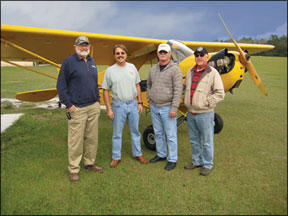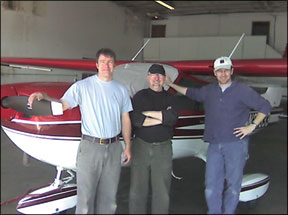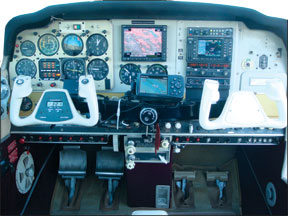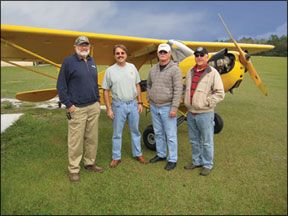On the surface, co-owning an aircraft just makes sense. Most airworthy privately-owned light singles fly less than 100 hours a year-in many cases far less. Regular use is better for the aircraft and better for amortizing the fixed costs (hangar, insurance, databases) per hour of flight. More users should mean more bang for everyones buck. Unfortunately, several owners also mean more opportunities for conflicts in time, resources, flying style, opinion and even personality. Being connected to anyone by your checkbook can put a strain on the best relationship. There’s no magic formula for creating the right partnership. But our survey results hit the same key points with metronome-like regularity: Good partnerships have clear expectations between partners of similar economic standing, and they have written rules or bylaws to settle disputes.
Equally Deep Pockets
The prevalence of comments like, “Our partnership has worked we’ll for so long because we have similar financial resources,” was a surprise to us at first, but it shouldnt have been. There are three big problems with unbalanced discretionary income among partners. The first is for maintenance and upgrades.
For example, if two partners are hard IFR fliers and want an approach-certified WAAS GPS and the third isn’t even instrument rated, there is often a conflict. Partnerships can weather such issues when the VFR pilot sees a payback. That might be as undefined as knowing the aircraft will be used more, or as concrete as a trade for the low-time pilots impact on the shared cost of insurance.
We saw several examples of upgrades where one or a few of the aircraft partners shouldered the whole cost because they felt passionate about the need. One of these was a $27,000 avionics upgrade-not exactly chump change. Other partnerships ended because of unresolved differences in what an airplane “needed.” Similar comments came up about maintenance-all members must have the same philosophy, be it “fix it now” or “shop on eBay.”
The second issue is that each partner must be able to comfortably afford the dues and fixed costs. “The most damaging thing would be a partner that is stretching himself to make the payments,” one respondent told us. “A bad partnership is one thing, but having to sell the plane or find another partner quickly is worse.”
The third facet to the economic resources issue is that few of the partnerships we heard about built a full reserve cost into the hourly rate for their airplane. While this may seem foolish, in a partnership of a few members, there’s a reasonable logic. Money put into a reserve fund typically wont make as much profit for the individuals and certainly isn’t available as liquid cash. The partnership may not last or may move to a different aircraft before a major engine or airframe bill comes in.
One part-owner in a late-model Seneca added this point about not collecting for an engine overhaul: “To do so would break a psychological barrier for us of paying more than $200 an hour for flying or more than $1000 per month in fixed expense.”
If that sounds like a bit of self-delusion to make flying seem cheaper, well, maybe it is. Few partnerships volunteered hard numbers for their real, per-hour costs and many admitted they didnt know and didnt want to. Of the few we did see, dividing their reported hours flown by their reported costs showed rates that might be higher than youd expect with a partnership: $230/hour for a Beech Bonanza, $170/hour for a Cirrus SR20, $150-$125/hour for an older Cessna 172. In none of these cases was there a set aside for engine replacement or major upgrades.
Of course, we did hear of some real deals, like the nine pilots in an Aeronca Champ who each chip in $25/month and $25/hour wet. A similar group, at a fly-in community, shares a Piper J3 who split insurance and other costs as they come up. The often

do the maintenance themselves. The only hourly cost of the plane is to refill the tank. Were still trying to find out where these guys live.
The takeaway is that a solid partnership mitigates the financial sting of ownership by spreading out costs, but its not slam-dunk cheaper than renting or being part of a larger flying club-especially if youre not flying that many hours or there’s a big, unexpected bill to pay.
One thing we did hear was that partnership offered more airplane for the same net investment. People who were renting Cessna 182s were now partners in a Piper 6X or a Mooney. Or they were in a plane that wouldnt be available any other way, as Chris Cussen told us: “I would not be able to do the flying I do without a partnership arrangement as there are very few Cessna 180s available for private hire. Those that are available would not be released for mountain/strip flying. I could not afford the costs associated with individual ownership.”
Partnership Structures
We had reports of partnerships from two to 10 members, with the most common being two to four. Reports of conflicts were rare. If anything, it seemed that with even four or five pilots the aircraft sat more than some members wished.
The magic number may be more in terms of hours flown than number of members. Happy partnerships reported 100-300 hours of use on the aircraft, with an ideal number being between 150 and 200. So the right number of players is the number that will net about 175 hours of flying time a year. One potential catch is that more than four or five members becomes a club for insurance purposes and significantly raises the rates.
Few partnerships reported conflicts when it came to scheduling. Most used e-mail or free web calendars from Yahoo or Google. If there was a conflict, usually the preference went to someone making the longer trip. Some partnerships use a rotating week where one member has first rights to the aircraft, usually on a Thursday-Wednesday schedule.
Many of the partnerships were corporations (see August 2008 Aviation Consumer for more on aircraft corporations). The gain here was the potential for some level of liability protection (we still feel good insurance is the first and best line of defense) and its an easier transfer of the asset as members come and go. The aircraft is owned by the corporation and doesnt change hands. Shares in the corporation are bought and sold. Some folks reported that having the corporation in place before the corporation even bought an airplane help new members feel OK with the commitment to get on board.
An additional benefit with the corporate structure is that ownership in the corporation didnt equate flying rights on the aircraft. A member who was behind on dues could be prevented from legally flying the plane, as could someone inheriting the share as part of a family estate. Thats not an option with outright ownership.
The downside of corporate structure can come in fees and hassle. Some states have yearly filing fees and requirements. Taxes become more complex, including depreciation of the asset. There are simply too many permutations to explore here, so we’ll leave that discussion for you and your accountant. Overall, the more members involved the more a corporate structure to the partnership makes sense.
We heard of a few alternate structures where only one member owned the aircraft and others chipped in the fixed and hourly costs. Some were a straight percentage of fixed and some only paid by the hour. This starts to sound a lot like rental, but it isn’t. Whether the aircraft is corporately held or privately owned, pilots can reimburse the owner for “operating expenses” on the aircraft they borrow without it being looked at as a commercial enterprise.
Leasebacks are another option that comes up for individual owners or small partnerships. While these may soften the cost

of ownership somewhat, its rare that they truly pay back and are a good deal for the owner. Primary trainers might be the exception.
Get it in Writing
Dennis Pelletier has been part of an 18-year-old partnership that first owned a Piper Cherokee and now has a Cessna Cardinal, and has seen many members come and go. “Some people want the cost benefits of a partnership, but don’t really have the flexibility, personality, or respectfulness required in a group … Every time weve experienced a difficult partner, there was either a hole in the partnership agreement (which has been amended a number of times over the years), or we didnt take enough time to insure the candidate properly understood the philosophy of our partnership.”
Even in partnerships as small as two people, having a written agreement for all aspects of the partnership was ranked high as a key component of success. The partnership agreement must cover how moneys will be collected and spent and policies for aircraft use. Many groups go further with details of aircraft operation-how it will be flown and in what conditions, how it will be left for the next user, and so on. We think the bigger the group, the more this matters.
The boilerplate partnership agreement AOPA offers (www.aopa.org/members/files/guides/agree.html) has 52 items on it. If youre setting up a new corporation, its worth making sure you have some plan for all these contingencies and that the big ones involving the asset-buying, selling, upgrades, inheritance, insurance-are agreed on paper and signed by all partners.
The paper agreement can be a way to weed out potential problem partners. In the responses we heard some partnership horror stories. There was one potential partner in a Cessna 172 who told the group hed be great because he only liked to fly at night. He really wanted the plane for hauling light cargo after hours (it wasnt clear what was meant by “cargo” either). There was another group where one member was an instructor and chose to give instruction in the plane at his low usage rate. Of that doomed partnership the person told us, “the wheels fell off.”
One critical item that is often overlooked is what happens when a partner cant fly for some period of time due to a financial, medial or other issue. Many partners choose to stay in the plane, still paying their share of the fixed costs, or some pre-agreed reduction. We heard of one case of 10 partners in a Cessna Cardinal where only four fly.
A Committed Relationship
Brian Bailey told us about his Cirrus SR22 partnership, “We fly together often and ask each other questions about procedures, avionics use, maintenance etc., trying to stump each other with some obscure aviation related question. It makes both of us better pilots.”
Perhaps thats one of the intangibles of a good partnership. Its an opportunity to raise your bar on professionalism just due to peer pressure and keep up your enthusiasm for flying. Weve heard of more that one case where a new partner pumped up sagging spirits of the other owners.
There’s also the fact that with only a few people to negotiate with, owning an aircraft means real freedom of use. Mac McCarthy is a partner in a 1983 Mooney. “It allows me to fly the way I like. While there are still a lot of rentals available, they all charge you a daily fee when you go on longer trips. And try renting one to go to the Bahamas or Belize. Its also kinda neat, like being a kid again. You have a club that only a select few can join, you have a ball doing it and others think youre rich.”
Jeff Van West is Aviation Consumers managing editor.


